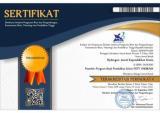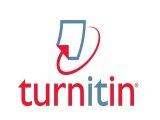Gagasan Model Pembelajaran Mobile–NOS Untuk Peningkatan Literasi Sains Siswa
Abstract
students' scientific literacy and student responses to these ideas. This article is
compiled based on literature studies, simple observations on several variables
supporting mobile learning at IKIP Mataram, and evaluating prospective user
responses to the development idea using a questionnaire. Respondents were 54
students of IKIP Mataram Chemistry education. The response data is processed
by percentage formula based on category criteria. Mobile-NOS learning is
learning that applies the Nature of Science (NOS) learning steps with the support
of learning media in the form of mobile applications that can be applied in smart
mobilephone. The six main steps in implementing learning are oriented to Nature
of Science (NOS), namely: (1) Reading the context on electronic articles; (2) Indepth
questioning; (3) Observation of cases and targets; (4) Demonstration
Procedure; (5) Library Search; (6) Implementing Procedures; (7)
Communicating Science Knowledge; and (8) Authentic Assessment.The results of
this study showed an average response to the idea of developing NOS-oriented
mobile learning at 85.23% with a very good category.
Keywords
Full Text:
PDFReferences
Abd-ElKhalick, F., &Lederman, N.G. (2001). Improving science teachers‟ conceptions of
nature of science: A critical review of the literature. International Journal of Science
Education, 22(7), 665-701.
Alden, J. Accommodating Mobile Learning In College Programs. Journal of Asynchronous
Learning Networks, Volume 17: Issue 1 pp. 109-122
Buckner, E., & Kim, P. (2013). Integrating technology and pedagogy for inquiry-based
learning: The Stanford Mobile Inquiry-based Learning Environment (SMILE).
Prospects Quarterly Review of Comparative Education ISSN 0033-1538.Prospects
DOI 10.1007/s11125-013-9269-7.
Cabanban, C. L.G. 2013.Development of Mobile Learning Using Android
Platform.International Journal of Information Technology & Computer Science, Vol.
No. 1, pp. June, 2013. Artikel telah disajikan dalam : 3rd International Conference
on E-Learning and Knowledge Management Technology (ICEKMT 2013 ) ,
Bangkok, Thailand on April 6 - 7, 2013 pp. 98 – 106.
Calimag, J. N., Mugel, P. A., Conde, R. S., & Aquino, L. B. (2014). Ubquitous learning
environment using android mobile application. International Journal of Research
inEngineering & Technology, 2(2), 119-128.
Celik, S. 2014. Chemical Literacy Levels of Science and Mathematics Teacher Candidates.
Australian Journal of Teacher Education. 39(1).
Fives, H., Huebner, W., Birnbaum, A.S., Nicoloch, M. (2014). Developing a measure of
scientific literacy for middle school students. Science Education. 98: 549-580
Gormally, C., Brickman, P., Hallar, B., & Armstrong, N. (2009). Effects of inquiry-based
learning on students‟ science literacy skills and confidence. International journal for
the scholarship of teaching and learning, 3(2), 16.
Hudson, D. (2014). Nature of science in the sience curriculum: origin, development,
implications and shifting emphasis. In Mattews, M.R (Eds), International Handbook
of Research in History, Phylosophy and Science Teaching (pp. 911-970). New York:
Springer
Hanafi, H. F., & Samsudin, K. (2012). Mobile learning environment system (MLES): the
case of Android-based learning application on undergraduates' learning. arXiv
preprint arXiv:1204.1839.
HANDOKO, E. A. (2012). Analisis hakikat sains (the nature of science) dalam buku teks
pelajaran kimia SMA kelas XI. SKRIPSI Jurusan Kimia-Fakultas MIPA UM.
Haristy, D. R., Enawaty, E., & Lestari, I. (2013). Pembelajaran Berbasis Literasi Sains pada
Materi Larutan Elektrolit dan Non Elektrolit di SMA Negeri 1 Pontianak. Jurnal
Pendidikan dan Pembelajaran, 2(12).
Hofstein, A., Eilks, I., & Bybee, R. (2011). Societal issues and their importance for
contemporary science education: a pedagogical justification and the state of the art in
Israel, Germany and the USA. International Journal of Science and Mathematics
Education, 9 (6), 1459-1438
Lederman, N.G., And-El-Khalick, F., Bell, R.L., Schwartz, R.S. (2002). Views of nature of
science questionnaire: toward valid and meaningful assessment of learners‟
conceptions of nature of science. Journal of Research in Science Teaching, 39(6):497-
Lederman, N. G., Lederman, J. S., & Antink, A. (2013). Nature of science and scientific
inquiry as contexts for the learning of science and achievement of scientific
literacy. International Journal of Education in Mathematics, Science and
Technology, 1(3).
Laugksch, R. C. 2000. Scientific literacy: A conceptual overview. Science Education,
(1),71-94.
http://dx.doi.org/10.1002/(SICI)1098237X(200001)84:1<71::AIDSCE6>3.0.CO;2-C
New Zealand Curriculum Guides. (2013). Senior Secondary Science. Wellington: Ministry of
Education
Osborne, J., Collins, S., Ratcliffe, M., Millar, R., & Duschl, R. (2003). What „ideasaboutscience‟
should be taught in school science? A Delphi study of expert
community. Journal of Research in Science Teaching, 40(7):692-720
PISA 2015.2013. Draft Science Framework, 1–54.
Rahayu, S. (2016). Mengembangkan Literasi Sains Anak Indonesia melalui Pembelajaran
Berorientasi NatureofScience. Makalah disampaikan pada Sidang Terbuka Senat
universitas Negeri Malang, 17 Maret 2016.
Ratnawati, E. (2013). Pemahaman Hakikat Sains (NOS) Mahasiswa Tahun Ketiga Program
Studi Pendidikan Kimia Universitas Negeri Malang. SKRIPSI Jurusan Kimia-
Fakultas MIPA UM.
Rychen, D. S.,& Salganik, L. H. (Eds.). (2003). Definition and Selection of Key
competencies: Executive Summary. Göttingen, Germany: Hogrefe
Santyasa, I. W. (2006). Pembelajaran inovatif: Model kolaboratif, basis proyek, dan orientasi
NOS. Semarapura: Makalah.
Shwartz, Y., Ben-zvi, R., & Hofstein, A. (2006). The use of scientific literacy taxonomy for
assessing the development of chemical literacy among high-school students, Journal
of Chemistry Education Research and Practice: 7(4), 203–225
Toharudin, U., Hendrawati, S., & Rustaman, A. (2011). Membangun literasi sains peserta
didik. Bandung: Humaniora.
Tsaparlis, G. 2000. The states-of-matter approach (SOMA) to introductory chemistry.
Chemistry Education Research and Practice, 1(1), 161-168.
http://dx.doi.org/10.1039/a9rp90017a
UNEP. 2012. 21 Issues for the 21st Century: Result of the UNEP Foresight Process on
Emerging Environmental Issues. United Nations Environment Programme(UNEP).
Nairobi, Kenya.
Wenning, C. J. 2006. “A Framework for Teaching the Nature Of Science”. Journal of Physics
Teacher Education (Online, http://www.phy.ilstu. edu/jpteo. Diunduh tanggal 12
Oktober 2017).
Wiliam, D. 2010. What Counts as Evidence of Educational Achievement? The Role of
Constructs in the Pursuit of Equity in Assessment. Review of Research in Education,
, 254-284.
DOI: https://doi.org/10.33394/hjkk.v6i1.1600
Refbacks
- There are currently no refbacks.

This work is licensed under a Creative Commons Attribution-ShareAlike 4.0 International License.





